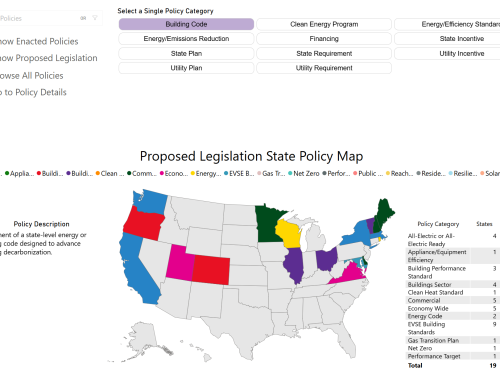
Every few years, the Energy Information Agency (EIA) sends around the Commercial Buildings Energy Consumption Survey (CBECS), a national sample survey of commercial buildings and all of their energy-related characteristics and activities. The latest CBECS was performed in 2018; the data was packaged by the EIA and released in December 2022. And earlier this month, Buildings Hub launched our 2018 Commercial Building Characteristics dashboard.
A “commercial building” according to the EIA is any building where the majority of its floorspace is used for purposes that are not residential, industrial, or agricultural. As a result, the 6,436 respondents include traditional commercial buildings like offices, restaurants, and stores, as well as nontraditional commercial buildings like schools and hospitals. Just under six million buildings are represented by the data, with summary data available for U.S. Census-designated regions and divisions.
Here are some of the high-level narratives presented in the data.
The South is the most electrified region for (almost) every building activity.
The South continues to lead every other region in the country in terms of the proportion of electrified building activities. A third of commercial buildings in the South are all-electric; the West follows at 19percent and the Northeast and Midwest both sit at 12 percent. The South Atlantic census division — consisting of Delaware, Florida, Georgia, Maryland, North Carolina, South Carolina, Virginia, West Virginia, and the District of Columbia— tops the divisional statistics, with a 39 percent all-electric commercial building stock.
56 percent of the South and 62 percent of the South Atlantic division primarily utilize electric space heating. The Northeast lags in this category, with 19 percent of the region deploying electric space heating. Finally, water heating is the most electrified activity across the commercial building stock, with 61 percent of buildings nationwide using electric water heaters. In the South, this rate is 70 percent; the Northeast (56 percent), Midwest (55 percent), and the West (54 percent) all have comparable rates of water heating using electricity.
The only building characteristic the South lags in is solar panel deployment, at just 0.6 percent of commercial buildings, or 12,200 panels used. Here, the West leads at four percent deployment, or 47,700 panels used.
The most common commercial heating equipment? No heating equipment at all.
Almost a fifth of commercial buildings nationwide have no heating equipment, topping both natural gas and electric-run packaged units. It is encouraging for the heat pump deployment landscape that 18 percent of commercial buildings with heating equipment have electric heat pumps; of those heat pumps, 92 percent are air-source, five percent are water loop, three percent are geothermal, and the rest are a combination thereof. The highest rate of heat pump deployment is again in the South, with 26 percent of the region with space heating utilizing electric heat pumps. Also, due to the relatively warm climate across the region, a significant proportion of the region (18 percent) does not have any heating equipment.
The Midwest lags behind the rest of the country in heat pump deployment, with nine percent of commercial buildings using electric heat pumps. It is also the region most dependent on piped gas (51 percent) and propane (10 percent).
Overarchingly, about a third of commercial buildings nationwide are heated with electricity. 40 percent rely on piped gas, six percent on propane, and four percent on fuel oil.
Aging buildings and heating/cooling systems represent opportunities for electrification.
A new CBECS question asked respondents to describe what renovations a building has undergone since 2000, if any. About a quarter of the commercial building stock is relatively new in that they were built after 2000. The average year of construction, however, is 1981, making the average commercial building 44 years old.
Building codes across the country have changed substantially in the past four decades, as have the kinds of building materials used and technologies installed for heating, cooling, and other building activities. As a result, older buildings are more likely to be less energy efficient and more likely to rely on natural gas.
Weatherization renovations seem to be the least common, with window replacement (eight percent), insulation upgrades (five percent), and structural upgrades (two percent) sitting in the single digits of occurrence across commercial buildings since 2000. Lighting and HVAC equipment upgrades are the most common at 17 percent each, but the majority of the commercial building stock have not upgraded their heating or cooling systems in the past 20 years. Healthcare buildings have undergone the highest rate of HVAC upgrades since 2000, at 36 percent of outpatient and 27 percent of inpatient buildings.
All of this data comes directly from visualizations on Buildings Hub’s 2018 Commercial Building Characteristics dashboard. Check out the data tool to explore the newest information about our commercial building landscape and make comparisons with our 2012 CBECs tool.



